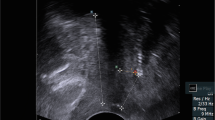Summary
The use of transvaginal ultrasound (7.5 MHz, linear array) during urethral instability enabled us to describe three movements that were seen during the urethral pressure drops: a shortening of the urethra (relaxation of the striated sphincter), an increase in the distance between the probe and the symphysis pubica (relaxation of the levator ani muscles) and a forward displacement of the “prepubien”. During ultrasound examinations (endovaginal and vulvar), the prepubien and its movements are easily visible in the space located between the external urethral meatus and the clitoris. The drop in urethral pressure is sometimes associated with an urgent need to urinate. In 75% of the patients, finger compression of the prepubien on the symphysis inhibited urethral instability and urgency. After all classic treatments for pollakiuria, nocturia and urge incontinence had failed, we tried to cut the prepubien in patients who were under general anesthesia. This operation was carried out in 19 women, of whom 13 were cured (68%), 5 showed improvement and 1 was a failure. Only two short-term side effects were observed: a sexual disability that lasted for 2 months and a labial haematoma.
Similar content being viewed by others
References
Abrams P, Blaivas JG, Stanton SL, Andersen JT (1988) The standardisation of terminology of lower urinary tract function. Scand J Urol Nephrol [Suppl] 114:5–19
Aranda B, Letzt-Ribinik P (1988) Activité cérébrale et pression uretrale. In: Urodynamique et neuro-urologie. Monographie de la SIFUD, vol 2. FIIS, Paris, pp 53–60
Beco J (1988) La section du “prépubien”: un nouveau traitement chirurgical de certaines instabilités uretrales. In: Urodynamique et neuro-urologie. Monographie de la SIFUD, vol 2. FIIS, Paris, pp 175–179
Beco J (1991) Echographie endovaginale en urologie. In: Perrot N, Boudghene F (eds) Echographie endovaginale, collection d'imagerie radiologie. Masson, Paris, pp 107–128
Beco J, Sulu M, Schaaps JP, Lambotte R (1987) Une nouvelle approche des troubles de continence chez la femme: l'échographie urodynamique par voie vaginale. J Gynecol Obstet Biol Reprod (Paris) 16:987–998
Bologna U (1973) Proceduria chirurgica per il trattamento dell'incontinenza urinari da sforza. Minerva Ginecol 25:413–420
Cardozo L, Stanton SL, Williams J (1979) Detrusor instability following surgery for genuine stress incontinence. Br J Urol 51:204–207
Dorschner W, Hofner K (1989) Die Harnkontinenz der Frau — eine morphologische Studie. Z Urol Nephrol 82:201–208
Hilton P, Mayne CJ (1988) Urethral pressure variations: the correlation between pressure measurement and electrical conductance in genuine stress incontinence. Proceedings, 18th Annual Meeting of the ICS. Oslo, Norway, 1st–3rd September
Huisman AB (1983) Aspects on the anatomy of the female urethra with special relation to urinary continence. Contr Gynecol Obstet 10:1–31
Ingelman-Sundberg A (1982) Operative treatment of female urinary incontinence. Ann Chir Gynecol 71:208–220
Jacquetin B, Lemery D, Decamps C, Suzanne F (1991) Normal ultrasonic anatomy of the female lower urinary tract with vaginal endosonography. Proceedings, 1st World Congress of the International Society of Ultrasound in Obstetrics and Gynaecology, London, January 7–10.
Koonings P, Bergman A, Ballard CA (1988) Combined detrusor instability and stress urinary incontinence: where is the primary pathology? Gynecol Obstet Invest 26:250–256
Kramer AEJL, Venema PL (1984) Dynamic urethral pressure measurements in the diagnosis of incontinence in women. World J Urol 2:203–207
Mouchel J (1990) Traitement chirurgical de l'incontinence d'urine `a l'effort chez la femme par soutenement sous-uretral à l'aide d'une bandelette de polytétrafluoro-éthylène. Rev Fr Gynecol Obstet 85:399–405
Sand PK, Bowen LW, Ostergard DR (1986) Uninhibited urethral relaxation: an unusual cause of incontinence. Obstet Gynecol 68:645–648
Spernol R, Riss P (1982) Paraurethral lidocaine in motor and sensory urgency. Proceedings, 12th Annual Meeting of the ICS, Leiden, 2–4 September
Vereecken RL, Das J (1985) Urethral instability: related to stress and/or urge incontinence? J Urol 134:698–701
Zacharin RF (1968) The anatomic supports of the female urethra. Obstet Gynecol 32:754–759
Zeegers AGM, Kiesswetter H, Kramer AEJL, Jonas U (1987) Conservative therapy of frequency, urgency and urge incontinence: a double blind clinical trial of flavoxate hydrochloride, oxybutinin chloride, emepromium bromide and placebo. World J Urol 5:57–61
Author information
Authors and Affiliations
Rights and permissions
About this article
Cite this article
Beco, J., Jossa, V. & Lambotte, R. “Prepubien” section: a new surgical treatment of frequency, nocturia and urge incontinence?. World J Urol 10, 120–126 (1992). https://doi.org/10.1007/BF00183146
Issue Date:
DOI: https://doi.org/10.1007/BF00183146




